The MGA With An Attitude
ORIGINAL WHEEL TYPES for the MGA -- WL-100
This is just a quick review of the original wheel types which were available for the MGA. The first picture on left is the 15x4" stock 48 spoke wire wheel, painted as original. Notice that all spokes terminate in a single row around the outside edge of the rim. I used to drive on these, back in the day (late 1960's). The wheels would hold up okay to the bias ply nylon tires. But I was always trying to justify the cost of a new set of Michelin radial tires, which I was told were all the rage in those days.
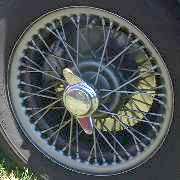
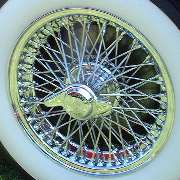

The center picture above is an optional 60 spoke wire wheel, 15x4-1/2", also painted. I was never quite clear on whether these could be factory installed or if they were dealer installed option, but I believe they could be factory ordered for the MGA 1600 MK-II cars. Notice that spokes from the outside end of the hub reach across to attach at the center well of the rim. This increased spoke angle imparts greater stiffness to the wheel, in addition to the increased number of spokes, so this wheel may be as much as 50% stronger than the 48 spoke wheel. It has 40 spokes at the outer edge of the rim and 20 spokes running to the center of the rim.
The picture on right shows a 72 spoke wheel, chrome plated. This has 48 spokes on the outer edge of the rim, and 24 angled to the inside. The spokes in this wheel are also commonly thicker (heavier gauge) than the wheels with fewer spokes, making it much stronger. These are also available with wider rims, commonly 5" to 6", or even wider. I believe the factory never put chrome plated wheels on an MGA. There was an optional competition wire wheel with aluminum rim and steel spokes, but those would have been painted to protect the steel spokes (no stainless steel used in the factory wheels).
Beware that wheels wider than 5-1/2 inches may have insufficient offset, and tires larger than 185-15 may run under the fenders and may rub on full bounce or with moderate body roll.
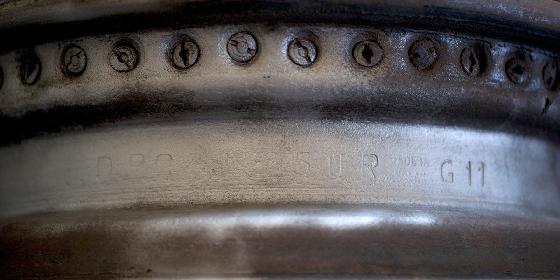
Picture from Peter Firkins in Tehachapi, USA, an original Dunlop
48-spoke wheel showing factoy stamping on the inside of the rim:
DPC 4J 15 UR MADE IN ENGLAND G11
Pictures below show the steel disc wheels used on the MGA. First on the left is the 15x4" wheel used for the MGA 1500. Notice the flattened transition of the center disk for about 1/2 inch width where it meets the outer rim, and the wide open slots in evey quadrant. There was a slight design change on this wheel at car number 50270 in March 1958 in the area of the center disk near the brake adjuster holes. See Confidential Service Memorandum MG/218 dated 1 May 1958. This was intended to make the wheel more resistant to cracking. Appaerntly it wasn't enough, as less than a year later a completely different wheel was introduced.
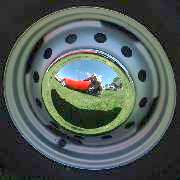
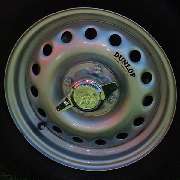
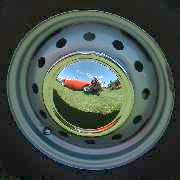
The center picture shows the 15x4" wheel used for the MGA 1600. Notice the larger bowl shape of the center disk, coming tangent to the inside of the rim with no flat transition, and slightly narrower slots at the quadrants. This wheel was actually introduced in February 1959 at car number 63577, three months before production of the 1600 model, so few thousand late production 1500 cars left the factory with these wheels. This is disclosed in Confidential Service Memorandum MG/253 dated 13 May 1959. The "1600" type wheels are both stronger and lighter than the earlier ones. The center disk is one gauge thicker material for better strength. The outer rim is one gauge thinner material for less mass, with net two pounds less overall weight and also somewhat less rotational inertia.
The last wheel on the right is used on the Twin Cam and "Deluxe" cars (with four wheel disk brakes). While it does have a center knockoff for quick change, it does not have splines in the hub. Where standard bolt-on wheel hubs have four threaded studs, the Twin Cam hubs have four holes, and the center adapter on the wheel has four mating alignment-drive pins for quick change. The Dunlop decal is a popular aftermarket accessory, not original issue. -- While a similar wheel (with 5 studs and wider) was used on some Jaguar cars of the period, it is excedingly rare and in short supply today, available only as vintage used parts. The only other car that used the 4 peg Dunlops was the Gordon Keeble GT, which used 5 1/2" wide versions. As they only made 99 of those, so the chances of finding a set of GK wheels for your Twin Cam are vanishingly small.
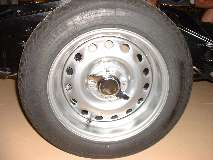
Picture on the right is a very rare factory optional aluminum Twin Cam wheel. Notice the increased depth of the rim outboard of the center disc due to this wheel being wider that the standard steel wheels.
medium image - large image
Photo below shows the 1500 and 1600 type wheels with wheel covers removed. There is an additional difference here with the through holes for brake adjusting. The 1500 wheel has two holes, while the 1600 wheel has one hole, and those holes are at slightly different distance from center of the wheel.
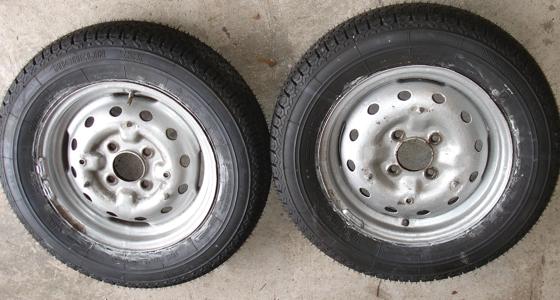
 Photo compliments of Paul Dean in Scotland. Photo compliments of Paul Dean in Scotland.
Addendum March 6, 2024:
A new revelation, and pictures to go with it. Where the standard Twin Cam Dunlop Knock-off Pin-drive steel wheel was 4-inch internal width, James Hambleton provides these pictures of similar style but various widths, with their original Dunlop part number stamped inside.

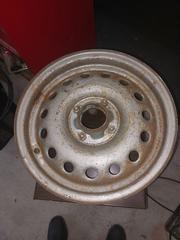
4 inch inside width
DRC4Jx15 LP776
(Hard to read stamping)
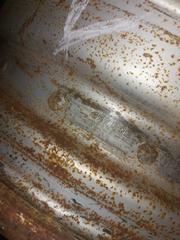
|
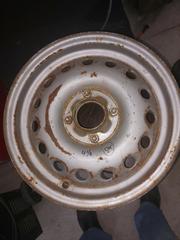
4-1/2 inch inside width
DRC4 1/2Jx15RU
Made In England LP886
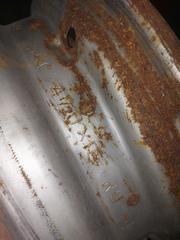
|
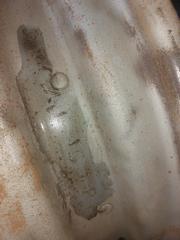
5 inch inside width
RD_15B5JBD
England LP_495
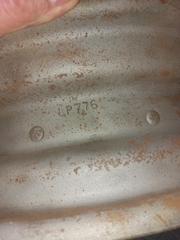
|

The 4-inch wide wheel was stock issue for the MGA Twin Cam (2111 cars built). We always thought the only place to get Dunlop 15 x 5-inch wide 4-bolt pin-drive wheels was from a Gordon Keeble, very rare with only 99 cars built. Then James came up with these 4-1/2 and 5-inch wide wheels. Nobody knows?
|














